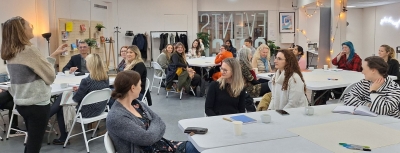
By Joe Pacitti, Managing Director, CeeD
It’s so refreshing and heartening to see that the events we run at CeeD really resonate with key topics, demonstrated by the fantastic turnout and engagement across our network. This, I believe, is the true value of CeeD and the peer-to-peer learning that these sessions encompass.
Take the Women in Engineering Network we have set up, following on from our Women in Engineering Day session we ran in the summer, where we explored ‘how do we do more and make this a sustained benefit for the sector?’ and ‘how can we bring this challenge of more women in engineering manufacturing, and indeed the whole STEM agenda, into an embedded norm’.
These themes were carried through at the event on 19 November 2024 which was hosted at Codebase in Edinburgh. Abi Hird, who attended both events and has set up her own company Defankle, acknowledged the efforts of CeeD and its constituent parts to embrace the journey of Diversity and Inclusion, which are essential for fostering innovation, creativity, and productivity in any industry but there is still more to do in the engineering and manufacturing space.
The challenge is certainly wider than just gender and we need to look at how we can do more as a community to make this journey a positive and empowering one, ultimately focussed on balance and growth.
Abi shared some interesting statistics:
- Businesses led by women deliver higher revenue, with a Boston Consulting Group study revealing a 35% higher return on investment than male-led counterparts.
- Women-founded startups accounted for 2% or less of VC funding invested in Europe and the United States in 2023 (Pitchbook data). Representation in VC decision-making roles is a factor.
- According to the Global Entrepreneurship Monitor, women now constitute 41% of the global entrepreneurial workforce.
So, it’s clear to see that, for a higher performing economy, we do need to ensure that gender balance is always part of our thinking – not just good for the opportunities this creates for the women in society but also for a healthy and prosperous society itself.
And it’s not just the voice of females we need to hear either, the male voice needs to be heard as well, to ensure that the perspective and views are balanced. As the only make in the room at our event, I was pleased to contribute to this important matter.
It was also heartening to hear that men too need to be considered and supported, in order to fully play their part.
While there is already a headway of effort and results in addressing the gender balance much of this is driven by women, but there is still work to be done. ‘Male allyship’ plays a pivotal role in accelerating this progress.
In exploring why this matters, and how men can actively contribute, it would be wrong not to re-emphasise the business case for gender diversity:
- Innovation and Creativity: Organisations with diverse teams are more innovative. Different perspectives lead to better problem-solving and more creative solutions.
- Ethical Imperative: Fairness and equality are fundamental values. Embracing diversity aligns with ethical principles.
- Profitability: Companies with diverse leadership perform better financially. Gender-diverse companies outperform their peers.
- Employee Well-Being: A diverse and inclusive workplace improves employee satisfaction, retention, and overall well-being.
Men still hold most leadership positions in business and government. For gender balance to become a reality, male leaders must actively contribute to change. Their influence can shape policies, practices, and organisational culture.
Male allies can make a significant impact by:
- Listening: Actively listening to women’s experiences and challenges.
- Supporting: Advocating for equal opportunities, fair treatment, and career advancement.
- Championing Ideas: Amplifying women’s voices and promoting their ideas.
- Challenging Norms: Questioning traditional gender roles and stereotypes.
The vibrancy of the economy is a key reason to get this right. Engineering and manufacturing plays such an important role worldwide, contributing to a prosperous economy, and dare we say it the challenges the planet faces are in the hands of not just politicians but also technology.
The challenges of balance make sense as the fruits of getting this right are demonstrated in findings which highlight the following:
- Progress: When men actively participate, 96% of organisations see progress in gender inclusion programmes2
- Event Participation: Men attending women’s conferences and employee resource groups (ERGs) foster better understanding and collaboration2.
- Flexible Work Environment: Male allies can help create a supportive work environment that attracts and retains women in manufacturing and engineering3.
So, the wider challenges we face in vibrancy and balance in the economy require us to pull all the levers we can. The challenge of male allyship is critical for achieving gender balance in manufacturing and engineering. By actively supporting women, men contribute to a fairer, more innovative, and successful industry. Let’s work together to create a future where everyone thrives.
We would love to continue this discussion with our members and hear more about the great work I am sure is going on across the CeeD network. Perhaps you can share some examples of what your organisation is doing on gender balance and the impact this has had on your organisation.
It would also be interesting to hear examples of how male allyship is working - and not just the view from the men involved but the women who have witnessed and experienced it too.
We’d like to feed this back into our Women in Engineering group – and if you’d like to be part of this group, please get in touch with a member of the team.
